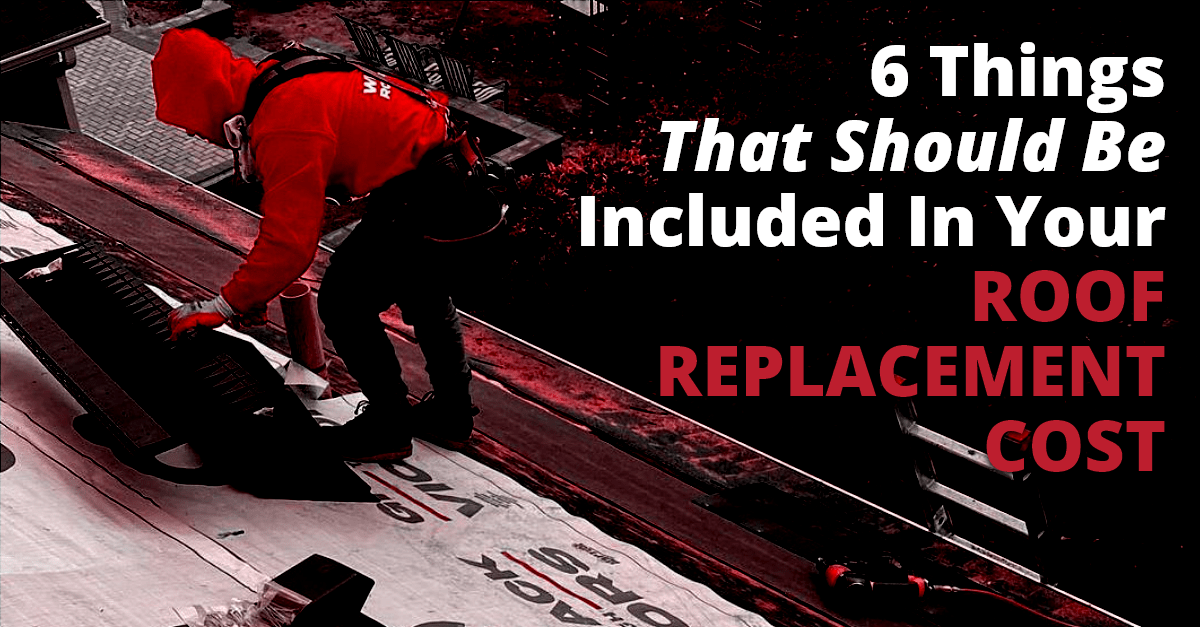Everyone knows to get estimates from local, reliable roofers before contracting with one for full roof replacement. Everyone may also know to get the estimates in writing, but what else? Does everyone understand what affects the estimate’s bottom line? Here are six things an estimate for a full roof replacement should include.
1. Height
A ranch home on a treeless six-acre lot is much easier to reroof than a three-story Victorian on a tree-covered quarter acre. The height of your home dramatically affects the ease of getting workers and materials into position.
Mechanical equipment has largely replaced the days when men tossed an 80-pound bundle of shingles over one shoulder, ready to climb a 45-foot extension ladder to the roof. Platform hoists and other gadgets speed up material movement, but height still matters.
Getting a square (100 square feet; three bundles) of shingles from the ground to the roof on a ranch house takes perhaps 30 seconds; getting it to the top of a three-story home takes, well, at least three times longer, adding time and labor costs.
2. Pitch
Roofs must have slopes to drain water from them. The slope of your Michigan home’s roof is called its pitch. The steeper the pitch, the taller the roof and steeper the angle. This helps water shed faster on a steep-slope roof than on a low-slope roof.
Pitch is measured as rise over run, which means how much your roof goes up vertically for every foot of horizontal measure. A gently sloping ranch home may have a 4-in-12, or 4-pitch, roof. This translates to a rise/run of ⅓, with the roof rising one inch every three. Such a roof is straightforward to walk on for trained professionals, though it does not shed snow, ice, and water readily.
A Colonial house may have a more dramatic 10-in-12, or 10-pitch roof. That is nearly a 45° angle (12-pitch would be 45°) and presents a lot of roof in a street view. Such a roof is highly challenging for roofers. It also adds a lot of roof to cover.
3. Square Footage
You may live in a 2,500-square-foot home, but that does not mean you have a 2,500-square-foot roof. Roofs overhang exterior walls, have angled sections, dormers, and all sorts of interesting features. The square footage of your roof is always greater than that of your home.
You can tinker with the numbers yourself using various online calculators, but generally, the greater the pitch, the faster the square footage adds up. As we saw with pitch, a steep roof exposes a lot of roof square footage. Add dormers and other features to increase the complexity and cost of the roof.
4. Layers
Building codes generally allow two roofs on a house, meaning a roofer can lay a new roof over an existing one. This simplifies the process but adds significant weight to the roof.
Your current, reliable roofer has to determine how many roof layers already exist on your home. Good roofers nearly always recommend complete tear-off rather than installing new over old.
Peeling away an old roof — metal panels, cedar shakes, tiles, asphalt shingles — adds to the time, labor, and carting costs. Yet it is almost always the better choice.
5. Material
The basic roofing materials — metal, ceramic or concrete tile, composite shingles, fiberglass-asphalt shingles — all have different prices. In that quick list, they are approximately listed according to cost from most to least expensive. Yet within each category, you can find other variations that change your bottom line and cause the estimate to vary:
Metal roofing can be panels, shingles, shakes, tiles, or natural metals like copper. Even within just metal panel roofing, you can have choices like standing seam, V-crimp, batten, deep-deck, and more.
Every material configuration affects your full roof replacement estimate. Do not be afraid to ask your roofer to suggest different shingle options, such as designer or architectural shingles.
6. Deck
Beneath your new roof is underlayment, sheathing, and rafters — your roof’s deck. It must be sturdy.
Sheathing can be plywood or oriented-strand board (OSB). For most roofing estimates, some sheathing sheets are built into replacement costs. Your roofer can advise on the right choice, thickness, and number you will need. Still, when the roofing crew pulls away the old roof, the old sheathing may be in worse shape than anticipated. You may have to pay for a few extra sheets.
Rafters — dimensional lumber on edge and supporting the roof — can rot, bow, or twist over time. All of these issues can be identified by your roofer and should be a part of your initial consultation and estimate conversation.
If your home is in the Southeast Michigan region, Victors Roofing is your residential roofer of choice. Contact us today to see how much we can do for you, from a careful roof inspection and honest estimate to a flawless finished roof installation.







